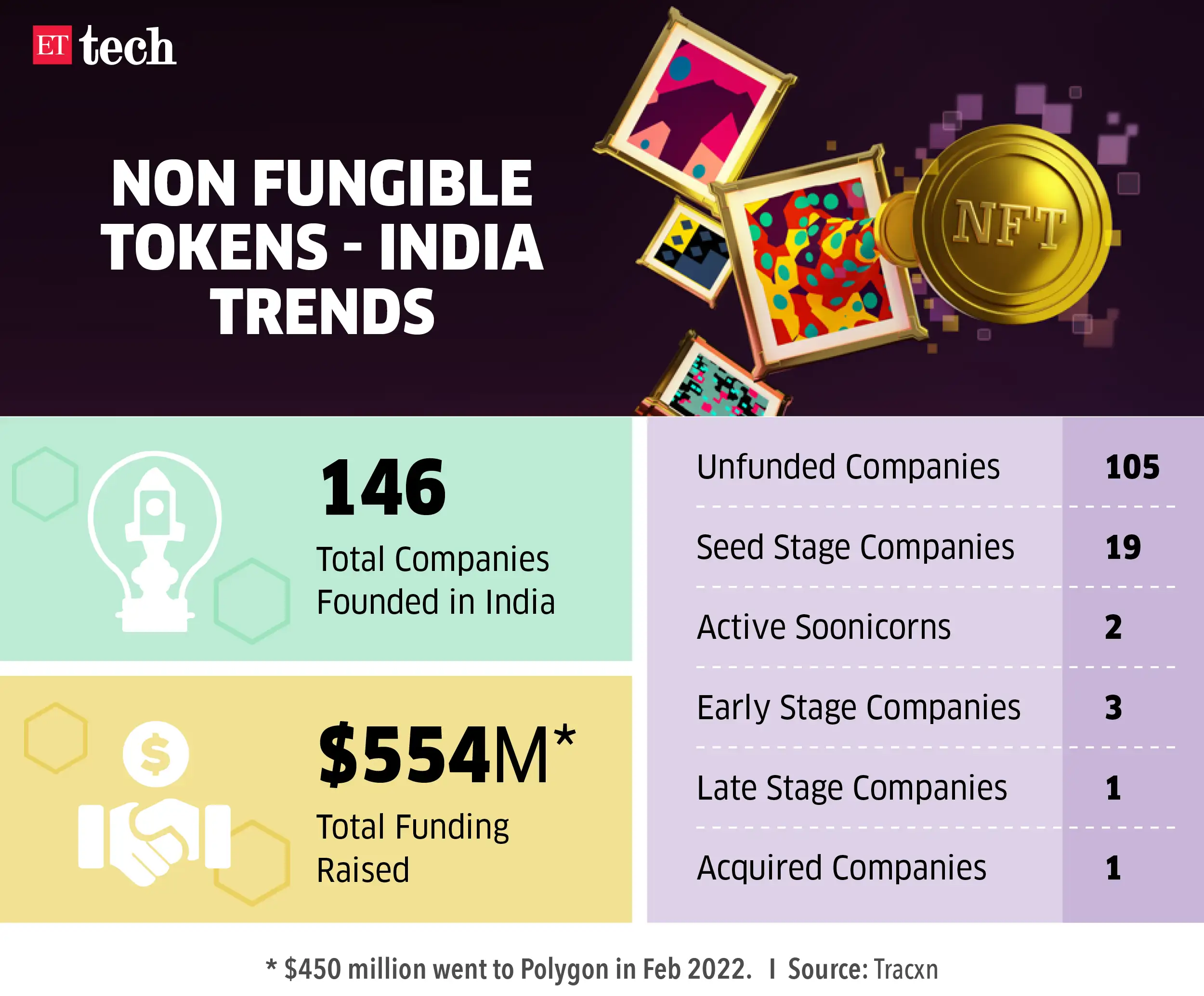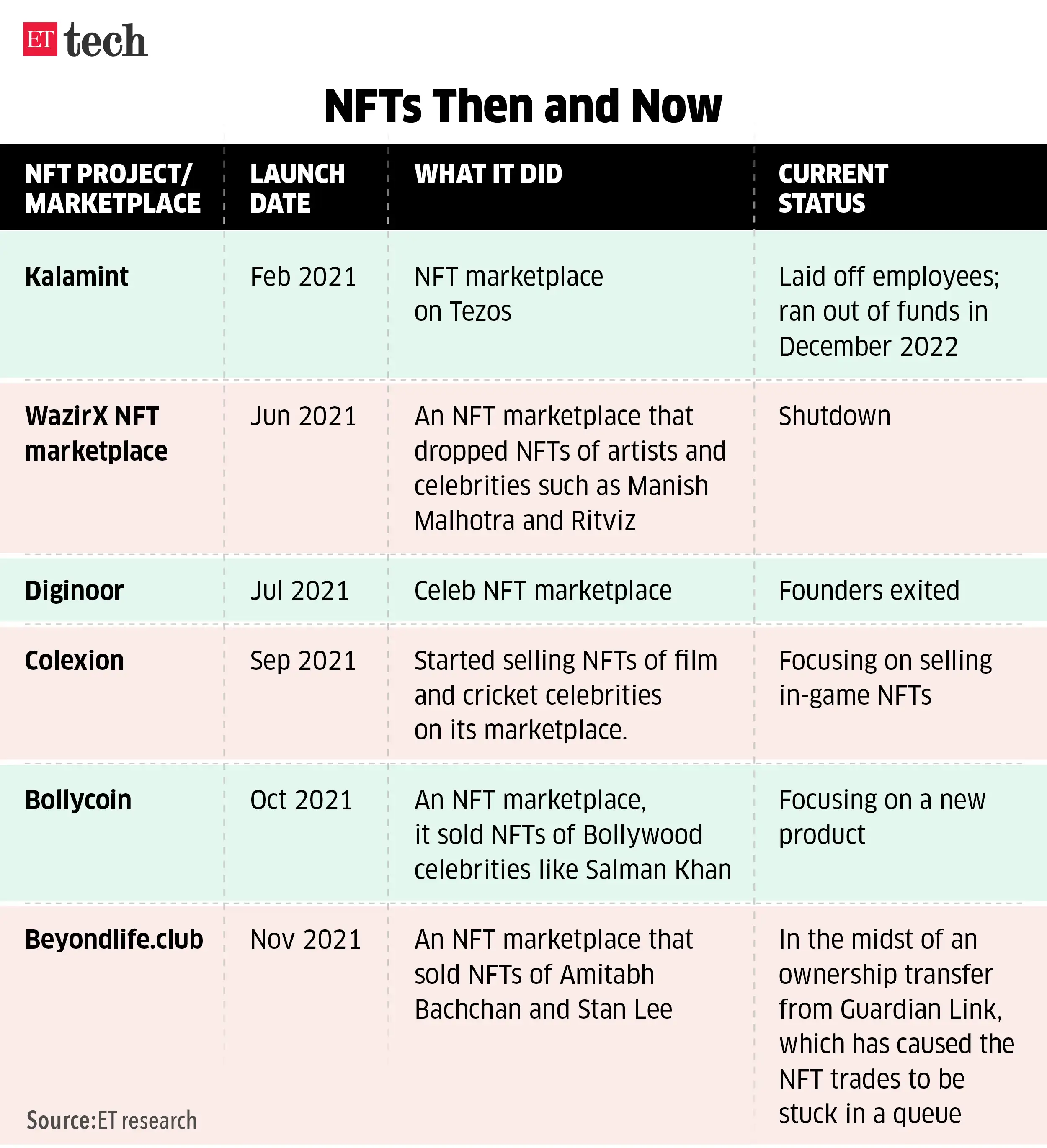“It was probably the first fashion-themed NFT drop in India,” he recalls.
This NFT — a digital certificate of ownership that is traceable on a blockchain — was one of the five exclusive tokens released by Malhotra on the WazirX NFT marketplace, which was launched with much hype about two years ago. Gopal, 38, has over 500 NFTs. He picked up an NFT of a Deewar poster of Amitabh Bachchan from a marketplace called BeyondLife.club and a trump card of cricketer Jasprit Bumrah from a cricket NFT platform called Fancraze. But there was something about Illuminous Showstopper. It came with bragging rights and new investment opportunities, he thought. He was wrong.
The fall in WRX’s value has meant Gopal’s Manish Malhotra NFT is now worth just `42,000 — about 19% of what he had paid. The value of his overall NFT portfolio has also eroded by 80% from its peak. Malhotra’s team declined to respond to a query from ET on whether the designer planned to add utilities such as access to exclusive content for his NFT holders.
These could have propped up the value of his NFTs and Gopal would have had something more to show with his Illuminous Showstopper. Even as the value of NFTs plummeted in the middle of a global crypto crisis, India’s NFT investors were faced with a double whammy. WazirX shut down its marketplace in February amid falling transaction volumes.
Discover the stories of your interest

The super-short history of NFTs has been chaotic — from the dizzying heights of hype to a bone-rattling decline in the wake of a crypto shakedown to a quick correction, a quiet realisation and, now, a pivot to utility.
The boom
NFTs rose from obscurity to mainstream popularity in 2021 after an NFT-backed artwork Everydays: The First 5000 Days by the American digital artist Mike Winkelmann aka Beeple sold for $69 million at a Christie’s auction. NFT sales volume soared to $24.9 billion that year, according to market tracker DappRadar. An NFT craze ensued in India as well. There was a deluge of celebrity projects. The number of NFT users in the country at the peak of the cycle in 2021 was pegged at around 1.5 million, according to Statista Digital Economy Compass 2022.
The crash
The crypto ecosystem began to feel the heat in the summer of 2021 itself. Cryptocurrency Luna collapsed on May 9. Then crypto lender Celsius went bankrupt.
By the winter of 2022, Sam BankmanFried, founder of one of the biggest crypto exchanges, FTX, was arrested on charges of fraud. Pranav Sharma, founding partner of Woodstock Fund, a Web 3.0 investment firm, says after the US Federal Reserve hiked interest rates, liquidity evaporated from marketplaces. “A lot of speculative applications (of NFTs) without clear, longterm utility and value simply collapsed,” he says.
“That led to the closure of marketplaces that had mushroomed in euphoric times. Many of them had focused on wash trading and non-compliance to attract volumes. This was unsustainable. This is a natural cycle of contraction of marketplaces which will turn around once two fundamental things are addressed: longterm utility of NFT use cases and liquidity in markets.”
He adds that NFTs are valuable containers of data and value, with wide-ranging use cases in consumer and financial services. In India, at least five NFT trading platforms have shut shop, run out of money, or pivoted to other models such as using NFTs as ingame assets.
Indian edition
India’s first NFT marketplace Kalamint, which was launched in February 2021 and climbed to the top 20 in seven months, ran out of funds in December last year amid falling trading volumes, according to an employee of the company.
Says its founder Sandeep Sangli: “We had to let go of the team and have been running it with an operational expenditure that we can manage via loans and personal funds until we figure out what’s next. We did not raise enough initially, and when the market turned to what it is, it became harder to raise additional rounds. That affected our growth trajectory.”
 ETtech
ETtechWhen WazirX platform shut down, it said monthly transactions had dropped to $112.24 and it had made just about $6 in fees while server expenses ran into thousands of dollars. NFTs was tipped as the future of the art world, the token that would revolutionise how art works are bought, sold and collected. In India, a bunch of entrepreneurs launched film and cricket memorabilia that had zero utility. These projects soon lost steam.
In September 2021, Colexion, a digital market place for NFTs, launched with much fanfare and partnerships with musicians Salim-Sulaiman, actor Suniel Shetty and singer Mika Singh. “That time we had a muted response and that is why we did not release NFTs. People did not know what to do with them and what could be their use,” says Abhay Aggarwal, founder, Colexion.
Aggarwal says they have wound up the entertainment division and the company is now focused on selling player card NFTs that can be utilised in an online cricket game and give holders access to signed merchandise. The platform has about 2,000 daily active users and 50,000 registered users from India.
“NFTs of celebrities did not go big because celebrities were not well-informed about it. A lot of projects had no utility,” he says. The very approach of some of the celeb projects was wrong, says Abhishek Sistla, cofounder of OmniFlix Network, a peer-topeer network for creators and communities to mint, manage and monetise NFTs.
“They were successful in generating hype if that was the objective. Several projects were focused on selling celeb NFTs instead of building a community. Since those projects could not be sustained, people lost confidence in those NFTs,” he says.
Experts whom ET spoke to say a lot of NFT projects were looking to capitalise on the hype, make a quick buck and exit, as it happens in any bull cycle. In December 2021, BollyCoin, an NFT platform founded by Atul Agnihotri, entered the market by dropping a pixellated image of Chulbul Pandey, his brother-inlaw Salman Khan’s character from Dabangg.
Now, BollyCoin is shifting its focus from trading platform to a new product called BollyShot, which allows users to fund content using tokens, according to a company spokesperson. “The marketplace is not shut, however, our focus is on BollyShot at the moment,” says the spokesperson, adding that the Dabangg NFTs have “iconic value”.
Diginoor, another celebrity NFT project backed by Polygon Fund and Cred’s founder Kunal Shah, was founded by two teenage entrepreneurs Shaamil Karim and Yash Rathod. In 2021, it sold Rajinikanth NFTs. Now, the marketplace has shut operations according to sources aware of the matter. According to Rathod’s LinkedIn profile, he has “successfully exited” the venture and Karim has moved on to work in an investment fund.
ET tried to reach the founders on Twitter and LinkedIn but did not get a response. “For those who have invested, there is always the possibility of these NFTs finding retrospective value as the earliest mints but it’s a long shot,” says Cyber Shakti, an NFT collector, artist and advisor to multiple projects.
Next chapter
A few NFT platforms have survived the bear market and are seeing consistent user growth. Tiger Global Capital-backed Fancraze and Dream Capitalfunded Rario are trying to tap the cricket fan base. Rario, a cricket NFT platform, says it has sold more than 1.5 million player cards and has over 700,000 users.
“A lot of people in this space took a technology-first approach and not a user-first approach,” says Ankit Wadhwa, cofounder, Rario. “For us the whole idea was to build a cricket fan club. We knew that the level of engagement in the sport is not commensurate to the fan base it has.”
 ETtech
ETtechWadhwa says their target market is 150-200 million cricket fans who engage in apps related to cricket. Jump.trade, launched by Kalaari Capitalbacked GuardianLink, is another NFT marketplace focused on cricket and racing games. Its tokens can be used in online games. It has about 60,000 active users in India, says Kameshwaran Elangovan, cofounder of GuardianLink.
Future NFT projects will be community focused, say experts, and could look beyond the arts. Dhruv Saxena, chief strategy officer of Singapore-based Vistas Media Capital, which had launched celebrity NFTs on Fantico, defines this shift: “When this chaos phase gets over, we will bring to the market NFTs with utility, maybe even financial utility. The community-building aspect is also very clear.”
Some startups are using the technology to grant memberships or bundle software. Like Pune-based StackOS, which intends to load NFTs with software. In 2022, Zostel launched over 700 NFTs which allowed users to get their trips planned for free by the company. Early this year, it set up Zo House, a membership-only club in Bengaluru for their NFT holders. It is a place to incubate and launch NFT artists in the Web 3 space.
Says cofounder Chetan Singh: “Our plan is to increase the value of NFTs for our users.” He says holders of Zo House NFTs have seen the value jump 10x as of date. “Our strength is in building a consumer business. That’s what we know,” he says. “But everyone has their own thesis and NFTs operate on a broad spectrum so use cases will evolve.”
























